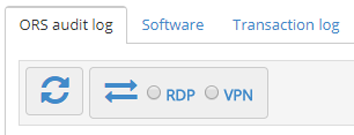

Remote assistance
Remote assistance is another component of the Remote Service. Remote assistance enables our organization to connect and support our customers remotely. Implementation is based on TeamViewer. The customer has to allow a remote desktop connection for the help desk employee.
Automatic license update
Updated licenses can be automatically downloaded and installed on the product from PRISMAdirect 1.2.0 onwards. An updated license is downloaded and installed automatically when:
The customer extends the maintenance period.
The customer has bought optional features.
Customers with a valid maintenance contract are entitled to software maintenance releases. From PRISMAdirect 1.2.0 onwards, the installer verifies whether a customer is allowed to install an update of the product. The customer is notified by a message at each refresh of the web page when:
The maintenance period date expires within 1 month. The customer can also verify the maintenance expiration date in the About box.
The license expires within 1 month. The customer can also verify the expiration date in the About box.
The customer is notified at the login screen when the license has expired.
A newly downloaded license is:
Announced to the user when there are changes at feature level.
Automatically installed on the local Floating License Server.
For a remote Floating License Server, the customer has to either:
Define a shared folder with the required rights.
Copy the license file manually.
Used within one minute after the installation of the license.
A valid license file must be installed in your local or remote Floating License Server.
There is no connection to the remote service back office when this option is disabled.
The ID and verification code identify your service organization. These settings are used to find your PRISMAdirect installation on the remote service website in the service organization.
The serial number is automatically retrieved from the license.
You have to define the proxy server settings when you need special permissions for TeamViewer in your network.
[Automatically detect settings]
The application detects the settings of your proxy server are automatically.
[Use proxy server]
You can define the settings of the proxy server manually. Use this setting when you want to use a dedicated proxy server.
[Proxy URL:]
The hostname and port. For example: proxy.example.com:8080
[Proxy server authentication]
Proxy servers that require authentication either require a username and password to access the Internet or authenticate users by using their current domain credentials.
[Proxy domain:]
The domain where the proxy server resides.
[Proxy user name:] and [Proxy password:]
The logon credentials for the proxy server.
Local Floating License Server
No action required. The new license will be installed automatically in the license folder "DroppedLicense".
You have to refresh the web page when the license is installed.
Remote Floating License Server
Define a shared folder with the required rights:
Share the license folder "DroppedLicense" on your remote Floating License Server. The [Remote service credentials:] user must have to following rights to the shared folder: Modify, Read, Write.
[Remote service credentials:]
The read-only text box displays the current remote service user. This user runs the Print ORS Service which offers the remote assistance functionality. Click [Test connection] to test if the defined user has Internet access.
You can change the user:
Click the [Change] button.
Select the domain and user name. Type the password. Letters in passwords must be typed using the correct case. The user must have Internet access.
Click the [OK] button.
The remote service user is changed.
Click [Test connection] to test if the defined user has Internet access.
If you don't want to create a shared folder, you can copy the license file manually.
The license file cannot be updated automatically because you haven't created a shared folder. Therefore, an error message appears informing you that the license cannot be updated on the license server.
Click [System] - [Remote Service].
Scroll to the bottom of the dialog to section [Failed to update license on:].
This section appears when a license cannot be updated automatically.
Click the save icon to save the license file on your computer.
Copy the license file from your computer to the folder "DroppedLicense" on the remote Floating License Server.
Green light
The connection to the remote service back office is established.
Orange light
The connection to the remote service back office has failed.
Remote assistance by our organization is based on TeamViewer. The help desk employee can request to allow a remote desktop connection for remote assistance.
Go to the “Oce Remote Service” web site and use your credentials to log in.
You can connect to TeamViewer when “RDP” and “VPN” are visible. “RDP” and “VPN” should be visible within 5 seconds after you have logged in.
